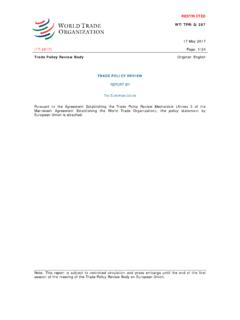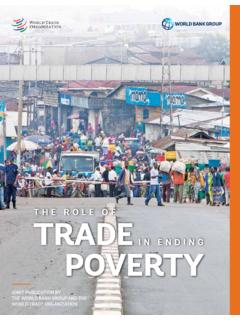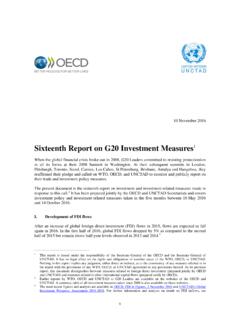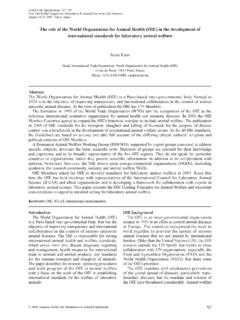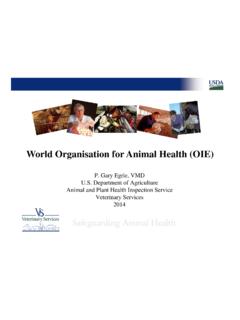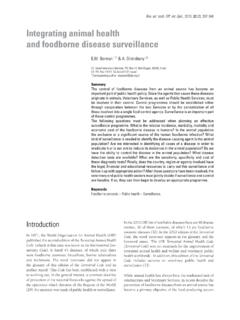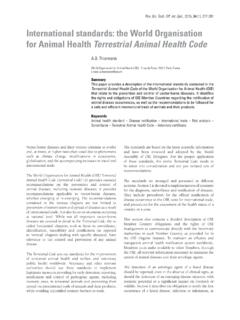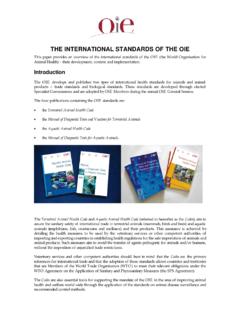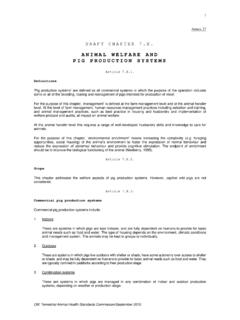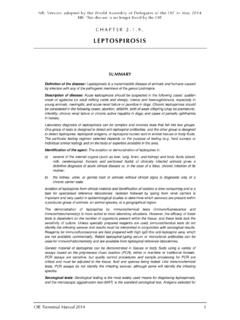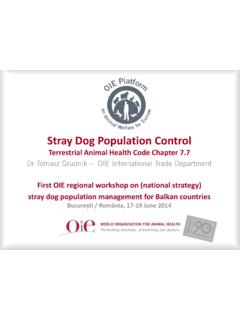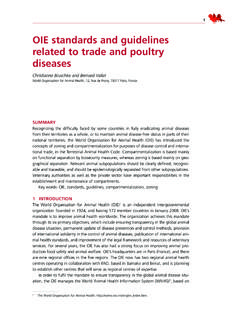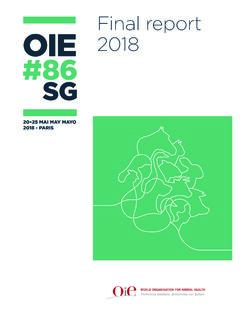Transcription of OIE International standards related to control, inspection ...
1 SPS Committee Thematic Workshop on Control, inspection and Approval Procedures (Annex C) 9-10 July 2018 WTO, Geneva Ann Backhouse OIE International standards related to control, inspection and approval procedures Head standards Department World Organisation for animal health Protecting animals, Preserving our future | 2 OIE related standards Future work programme Implementation of standards - challenges Introduction World Organisation for animal health Protecting animals, Preserving our future | 3 World Organisation for animal health Protecting animals, Preserving our future | 4 OIE standards Trade Measures, Import/Export Procedures and Veterinary Certification/ health Certification World Organisation for animal health Protecting animals.
2 Preserving our future | 5 Section 5 terrestrial Code Chapters Trade measures, import/export procedures and veterinary certification Chapter General obligations related to certification Chapter Certification procedures Chapter OIE procedures relevant to the Agreement on the Application of Sanitary and Phytosanitary Measures of the World Trade Organization Chapter animal health measures applicable before and at departure Chapter animal health measures applicable during transit from the place of departure in the exporting country to the place of arrival in the importing country Chapter Border posts and quarantine stations in the importing country Chapter animal health measures applicable on arrival Chapter International transfer and laboratory containment of animal pathogenic
3 Agents Chapter Quarantine measures applicable to non-human primates 6 6 Article Responsibilities of the importing country*1 1)The import requirements: should comply with the standards of the OIE, or be developed from risk analysis. 2)The International veterinary certificate: should NOT include diseases present in the importing country unless under official control. Conditions should not be more stringent for imports. 3)The International veterinary certificate: should NOT include diseases which are not OIE listed, unless supported by risk analysis. *also applies to OIE-recognized zones 1 Chapter General obligations related to certification 7 7 Courtesy Dr Nancy Bourgeois Chapter Includes recommendations re: animal identification Vaccination and testing Disinfection Premises of origin inspection Transport Notification Certification 8 8 Courtesy Dr Nancy Bourgeois Chapter Includes recommendations re: Rights and obligations of transit countries 9 9 Courtesy Dr Nancy Bourgeois Chapter Includes recommendations re: Facilities Personnel Organisation Notification 10 10 Courtesy Dr Nancy Bourgeois Includes recommendations re.
4 Rights and obligations of the importing country Certification Notification Disease concerns Emergency provisions World Organisation for animal health Protecting animals, Preserving our future | 11 Section 5 Aquatic Code Chapters Trade measures, import/export procedures and health certification Chapter General obligations related to certification Chapter Certification procedures Chapter OIE procedures relevant to the Agreement on the Application of Sanitary and Phytosanitary Measures of the World Trade Organization Chapter Criteria to assess the safety of aquatic animal commodities Chapter Control of aquatic animal health risks associated with transport of aquatic animals Chapter Aquatic animal health measures applicable before and at departure Chapter Aquatic animal health measures applicable during transit from the place of departure in the exporting country to the place of arrival in the importing country Chapter Frontier
5 Posts in the importing country Chapter Aquatic animal health measures applicable on arrival Chapter Measures concerning International transport of aquatic animal pathogens and pathological material World Organisation for animal health Protecting animals, Preserving our future | 12 Disease Specific Chapters and trade Designed to prevent the pathogenic agents of the OIE listed diseases, infections and infestations being introduced into an importing country Take into account the nature of the traded commodity, the animal health status of the country or zone or compartment and risk reduction measures applicable to each commodity. Assume that the agent is either not present in the importing country or is the subject of a control and eradication programme Recommendations for importation of animals, animal products including semen and embryos, where appropriate These standards assume that the agent is either not present in the importing country or is the subject of a control or eradication programme.
6 World Organisation for animal health Protecting animals, Preserving our future | 13 OIE standards oie terrestrial and Aquatic Codes Section 2. Import Risk Analysis World Organisation for animal health Protecting animals, Preserving our future | 14 Import Risk Analysis Guide importing countries in the conduct of risk analysis in the absence of recommendations on particular pathogens or commodities Importing country should also use this standard to justify import measures which are more stringent than existing OIE standards Details the process of risk analysis Based on recognised International principles Chapter World Organisation for animal health Protecting animals, Preserving our future | 15 OIE standards oie terrestrial Code Section 2.
7 OIE Aquatic Code Section 5 Criteria applied by the OIE for assessing safe commodities World Organisation for animal health Protecting animals, Preserving our future | 16 What is a safe commodity ?- means a commodity that can be traded without the need for risk mitigation measures specifically directed against a particular listed disease, infection or infestation and regardless of the status of the country or zone of origin for that disease, infection or infestation. COMMODITY ( terrestrial ) means live animals, products of animal origin, animal genetic material, biological products and pathological material. COMMODITY (AQUATIC) means aquatic animals, aquatic animal products, biological products and pathological material.
8 SAFE COMMODITY IS DEFINED IN THE terrestrial CODE World Organisation for animal health Protecting animals, Preserving our future | 17 Safe commodities Criteria - based on the absence of the pathogenic agent or inactivation of the pathogenic agent by treatment or processing The assessment of the safety of a commodity using the criteria relating to treatment or processing can only be undertaken where treatments or processing are well defined. Steps considered critical in the inactivation of the pathogenic agent should be detailed. Criteria to assess the safety of commodities World Organisation for animal health Protecting animals, Preserving our future | 18 Future work programme What are we doing to provide new or updated guidance for Member countries?
9 World Organisation for animal health Protecting animals, Preserving our future | 19 terrestrial Code Commission Work Programme Chapters in Section 5 of the terrestrial animal health Code already express some recommendations in relation to the import and quarantine of animals and the measures that are applicable on arrival. Chapters Revision to include: providing recommendations relating to control at border (not just with neighbouring countries), especially for the importation of live animals; considering whether there is a need for additional detailed guidance on the use of quarantine stations (both at departure in the exporting country or at arrival in the importing country); and align the chapters with the relevant listed disease-specific chapters as necessary.
10 World Organisation for animal health Protecting animals, Preserving our future | 20 Implementation of standards - challenges What is the OIE doing about the challenges to implementation of its standards ? World Organisation for animal health Protecting animals, Preserving our future | 21 What do we know about the challenges lack of technical expertise; outdated veterinary legislation; lack of confidence in applying risk management; lack of confidence in transparency; and failure on the part of both importing and exporting countries to respect OIE standards World Organisation for animal health Protecting animals, Preserving our future | 22 Conclusions of the Technical Item The OIE provides standards and recommendations based on evidence and science, reflecting and supporting good regulatory practice.




